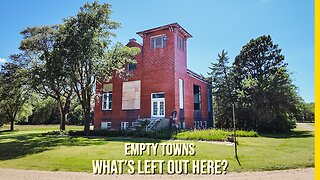Premium Only Content

Single-Family and Multi-Family rents ballon across the nation
The housing shortage has forced many potential buyers to move into rental properties as they look for their next home (and often find themselves on the wrong side of a bidding war). That option, however, is becoming increasingly expensive.
“When the pandemic hit, a lot of people left major cities which increased prices in the suburbs and exurbs. But as rents fell in the core metros, people returned, including those who couldn’t previously afford to live in core metros,” Leckie told Nexstar.
This caused demand and prices to increase to levels “at or beyond what we saw before the pandemic.” The pandemic’s impact on housing prices also pushed up rent prices. As would-be first-time homebuyers found themselves priced out of the market and stuck in rental properties, Leckie says demand for rentals rose even higher.
When looking at rent price trends throughout the U.S., Leckie found cities like Long Beach, California; Austin; and New York City have experienced some of the greatest year-over-year increases in the average rent prices. He said he believes people tend to seek out cities with a growing economy and jobs, as well as cultural amenities.
Moving forward, those cities that can offer each of these will likely be home to rising rent.
Rent prices jumped 12% last year for a median one-bedroom apartment, hitting an all-time high, according to Zumper, the nation’s third-largest real estate platform. A median two-bedroom apartment saw rent prices jump more than 14%. The median price for a one-bedroom rent reached $1,374 in January. The median price of a two-bedroom apartment reached $1,698.
The news comes as the latest S&P CoreLogic Case-Shiller National Home Price Index shows home prices for buyers in November jumped 18.8%✎ EditSign year-over-year. And experts are predicting a brutal spring housing market.
The rental escalations come after two years of essentially flat rent rates. Year-over-year growth in January 2021 was 0.6%, and in January 2020 it was 0.3%. And the skyrocketing rent prices are expected to continue.
“For the National Index to move by double digits takes incredible rent growth everywhere, and that’s exactly what occurred,” the Zumper report read. “The sudden increase in housing demand since the pandemic began in March 2020 exacerbated what was already a national housing shortage that dates back to the financial crisis in 2008, after which annual housing production dropped substantially. While some of the post-pandemic demand might fade as the pandemic becomes endemic, the housing shortage is a long-term issue that will likely continue to push rent up in 2022.”
New York, to little surprise, remains the most expensive place to rent, with the price of a one-bedroom jumping over 25% in the past year, while a two-bedrooms costs 27% more. San Francisco is second.
The real surprise, though, is the fast-rising cost of rentals in Boston, which could surpass San Francisco in the coming months. The median one-bedroom now costs $2,720, just $100 less than the California city (a 26.5% jump in one year), while a two-bedroom is $3,150, up 26%.
“It’s hard to overstate how astounding that is,” says the report. “In the winter of 2019, San Francisco’s median one-bedroom rent was $1,300 higher than Boston’s.”
Other cities that saw increases of more than 20% for two-bedroom units include Miami; San Diego; Scottsdale, Ariz.; Fort Lauderdale, Fla.; Seattle; Orlando, and Tampa.
“That’s for both major metros and smaller markets that meet those criteria,” Leckie explained. “Those that will decrease are cities that may have had a pandemic boom due to their natural amenities, but don’t have the infrastructure to support job creation and economic growth.”
Are you looking to move and want to avoid rising rent? You might want to avoid secondary markets and try for the Midwest.
“We’ve seen a lot of increases in areas surrounding Phoenix and other areas around Los Angeles, also in Orlando, Florida, and Portland, Oregon,” Leckie said. “We’re seeing decreases in a lot of Rust Belt cities like Toledo, Ohio; Indianapolis; and Pittsburgh, and in some Midwestern markets like Kansas City, Missouri, and Lincoln, Nebraska.”
While Leckie predicted rent prices will continue to rise through 2022, the rate of growth will likely be slower. The year-over-year percent change appears so high because of a dip in rent prices through 2020.
Rent growth is expected to reach about 7.1% in 2022, slightly lower than what we saw in 2021, according to Realtor.com’s analysis.
-
 1:14:04
1:14:04
NONCONFORMING-CONFORMIST
1 year agoYOU HAVE TO PAY A LOT AND IN SO MANY WAYS TO TAKE PART IN THIS WORLD
562 -
 LIVE
LIVE
FyrBorne
9 hours ago🔴Warzone M&K Sniping: Does Battlefield Pose A Threat To Call Of Duty BO7?
132 watching -
 24:19
24:19
DeVory Darkins
10 hours ago $3.56 earnedTrump scores RECORD BREAKING NEWS Democrats dealt FATAL BLOW after tragic event
5.15K9 -
 41:45
41:45
Chris Harden
7 days agoKansas Backroads | What's Really Out Here? - Rice County
6 -
 46:38
46:38
SouthernbelleReacts
6 days ago $0.02 earned"Smart Sharks, Dumb Decisions | Deep Blue Sea (1999) Reaction & Commentary"
501 -
 16:30
16:30
ColdBeer
4 days ago20 Best Action RPG Games like Diablo | 2025 Edition
4.32K3 -
 16:33
16:33
AndresRestart
14 hours agoHUGE Nintendo Game Release Date Info Just Got Out Apparently!?
24 -
 16:49
16:49
Eat Sleep Cruise
7 days agoOur HONEST Celebration Key Review - Carnival's New Private Island in The Bahamas
1.14K -
 8:41
8:41
nospeedlimitgermany
5 days ago $0.01 earnedBMW 316i E36 Compact 102 PS Top Speed Drive German Autobahn No Speed Limit POV
52 -
 25:38
25:38
Clownfish TV
14 hours agoAmerican Eagle Sydney Sweeney Situation is INSANE...
4.32K10